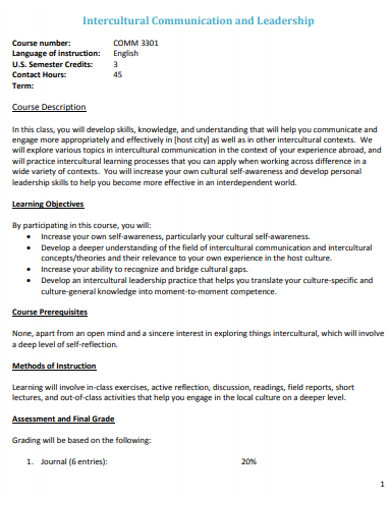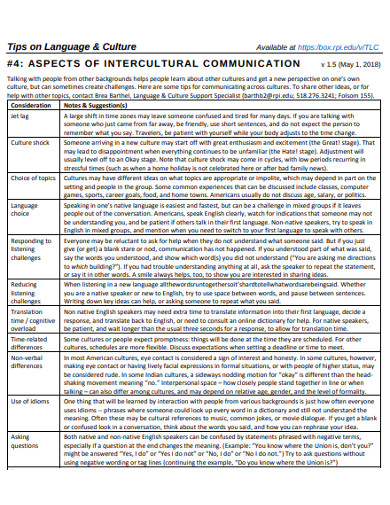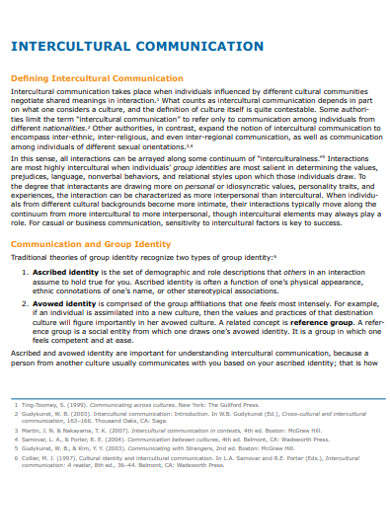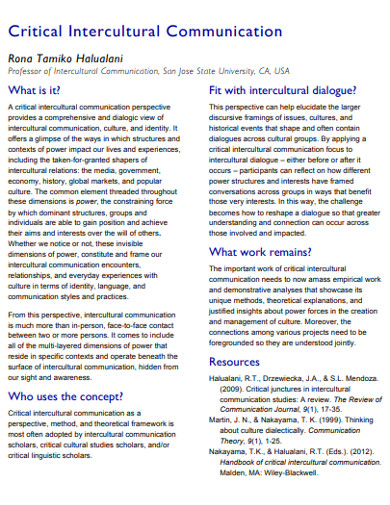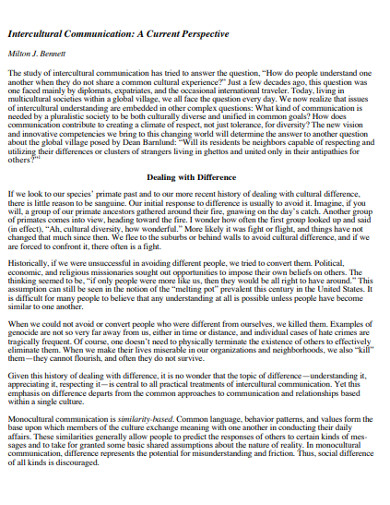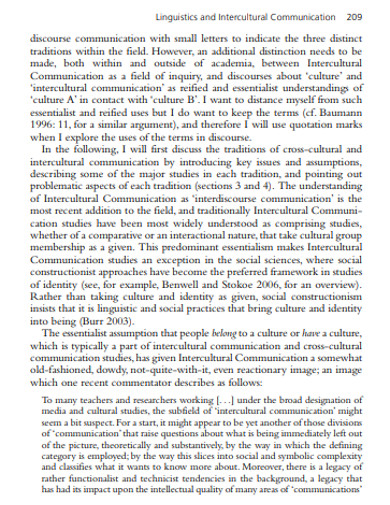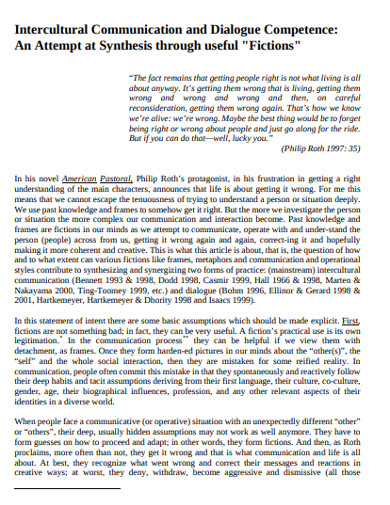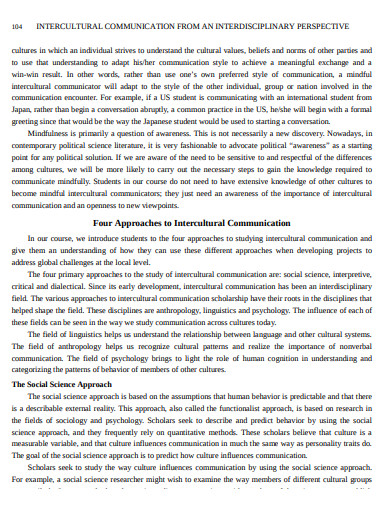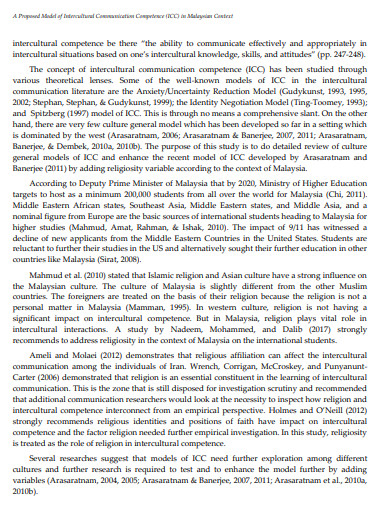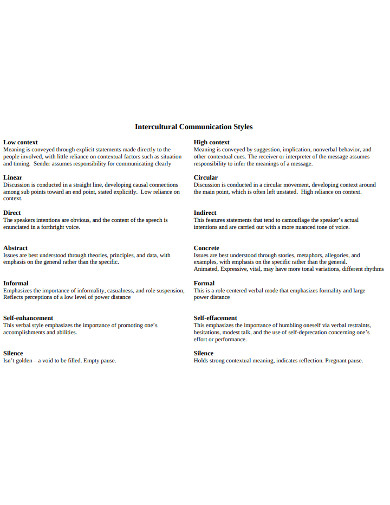100+ Intercultural Communication Examples to Download
Dive into the world of intercultural communication with our enlightening guide, where every interaction is an opportunity for growth and understanding. Learn to navigate the nuances of global dialogue, embracing diversity, and avoiding cultural faux pas. Our curated examples and practical tips equip you with the skills to communicate effectively across cultural boundaries, fostering mutual respect and enriching connections in our increasingly interconnected world.
What is Intercultural Communication? – Definition
Intercultural communication is the process of exchanging meaningful information between people from different cultural backgrounds. It involves understanding and respecting cultural differences to ensure messages are shared accurately and respectfully, promoting effective and harmonious interactions in diverse settings.
What is the Best Example of Intercultural Communication?
A classic example of intercultural communication is a multinational business meeting where participants from various cultural backgrounds come together. Each individual brings their own cultural norms, values, and communication styles to the table. Effective intercultural communication in this context involves recognizing these differences, adapting communication approaches accordingly, and ensuring that all parties are understood and respected, thus facilitating a productive and collaborative business environment.
100+ Intercultural Communication Examples
- Greetings Across Cultures: In Japan, bowing is a common greeting, while in New Zealand, the traditional M?ori greeting is the hongi, which involves the touching of noses.
- Business Card Exchange in Asia: The respectful presentation and receiving of business cards with both hands is a common practice in many Asian cultures.
- Dining Etiquette Differences: In some Middle Eastern cultures, eating with the right hand is the norm, while in other cultures, using specific cutlery for courses is expected.
- Personal Space Variations: In Latin American cultures, closer physical proximity is standard during conversations, unlike the larger personal space preferred in many Northern European cultures.
- Direct vs. Indirect Communication: Western cultures tend to value direct communication, while many East Asian cultures prioritize indirect communication to maintain harmony.
- High-Context vs. Low-Context Communication: High-context communication relies heavily on implicit messages and context, common in cultures like Japan, while low-context communication is more explicit and direct, typical in countries like the United States.
- Non-Verbal Communication in Italy: Italians are known for using expressive hand gestures to complement verbal communication.
- Gift-Giving in China: In Chinese business culture, giving and receiving gifts can be a significant cultural practice, symbolizing respect and building relationships.
- Time Orientation: Punctuality is highly valued in German business culture, whereas in some Caribbean cultures, a more relaxed approach to time is common.
- Negotiation Styles: Americans often use a direct and assertive style of negotiation, while Japanese negotiators may employ a more subtle and consensus-building approach.
- Consensus Building in Sweden: Swedes often use a collaborative and egalitarian approach to decision-making, emphasizing group consensus.
- Silence in Communication: In some Native American cultures, silence is a form of respect and a space for thought, rather than an awkward pause needing to be filled.
- Eye Contact Variations: While maintaining eye contact is considered a sign of attentiveness in many Western cultures, in some Asian cultures, excessive eye contact can be seen as confrontational.
- Use of Titles in Korea: The use of professional or honorific titles instead of personal names is a common practice in Korean culture to show respect.
- Gestures in India: The Indian head shake, often seen as a side-to-side tilt, can indicate agreement or acknowledgment, which may be misinterpreted by those from other cultures.
- Gift Wrapping in Japan: Presenting a gift that is meticulously wrapped is important in Japanese culture, as it shows care and respect towards the recipient.
- Physical Touch in Brazil: Brazilians often use touch during a conversation, such as a pat on the back, which might be less common in more reserved cultures.
- Formality in Russian Communication: Russians tend to use a formal approach when addressing others, especially in business settings, until a close relationship has been established.
- Use of Surnames in Hungary: Hungarians commonly address each other by their surnames first, followed by their given names, which is the opposite of the Western naming convention.
- Personal Questions in the Middle East: It’s common in Middle Eastern cultures to ask personal questions about family and health, which can be a sign of friendliness and interest.
- Indirect Refusal in Japan: In Japanese culture, it is common to refuse an offer indirectly to avoid embarrassment and maintain harmony.
- Communication Through Stories in Australia: Indigenous Australians often use storytelling to convey messages and teach lessons, embedding complex information within narratives.
- Spatial Arrangement in Arab Cultures: In some Arab cultures, meetings are often arranged in a circular seating to avoid hierarchies and promote openness.
- Use of Silence in Finland: Finns value silence and consider it a natural part of communication, not necessarily requiring a verbal response.
- Public Affection in France: The French may greet friends with a cheek kiss, which is a common and friendly gesture with no romantic implications.
- Listening Styles in Indigenous Cultures: Indigenous cultures often practice circular listening, where members of the group listen to each speaker in turn without interruption, valuing collective input.
- Expressing Agreement in Greece: Greeks may indicate agreement by tilting the head upwards, a gesture that might be interpreted as disagreement by others unfamiliar with the culture.
- Familial Conversations in Spain: In Spanish culture, conversations often include discussions about family early in the relationship, reflecting the importance of family in social interactions.
- Color Symbolism in India: In India, colors have significant cultural meanings, and choosing the right color for clothing or gifts can communicate respect and awareness.
- Formal Address in Japan: Using the honorific suffix “-san” after a person’s name is a way to express respect in Japanese social and business interactions.
- Workplace Hierarchy in South Korea: Communication in South Korean companies often reflects the hierarchical structure, with clear distinctions in language usage between different levels.
- Business Punctuality in Switzerland: Punctuality is a serious matter in Swiss business culture, and being late can be seen as a sign of disrespect.
- Mealtime Etiquette in Italy: Italians often view meals as a time for leisurely conversation and bonding rather than quick sustenance, reflecting a different cultural approach to dining.
- Personal Space in the United States: Americans generally prefer more personal space during conversations compared to other cultures, where standing too close might be uncomfortable.
- Greeting Elders in Nigeria: In Nigerian culture, it is customary to greet elders with a bow or curtsy as a sign of respect.
- Socializing After Work in Australia: Australian workplaces often encourage socializing after hours, reflecting the cultural value placed on work-life balance.
- Gender Roles in Communication in Japan: Traditional gender roles can influence communication styles in Japan, where women may use different language forms compared to men.
- Use of High-Context Language in France: The French often rely on high-context communication, where much is conveyed through implication and shared understanding rather than explicit statements.
- Gift-Giving Etiquette in China: In Chinese culture, gifts are often given with both hands and are not opened in the presence of the giver to avoid any appearance of greed.
- Conversational Overlapping in Italy: Italians may speak over one another in conversation, which is a sign of engagement and passion rather than rudeness.
- Non-Verbal Gestures in Turkey: In Turkey, a flick of the head upwards accompanied by a click of the tongue can mean “no” or “I don’t know.”
- Expressing Enthusiasm in Brazil: Brazilians often express enthusiasm and agreement with expressive gestures and animated tone, reflecting a warm and open communication style.
- Consensus in Decision-Making in Japan: Japanese business culture often seeks consensus (nemawashi) before making decisions, involving extensive discussion and group harmony.
- Directness in Dutch Communication: The Dutch are known for their directness in communication, which can be perceived as bluntness by those from more indirect cultures.
- Maintaining Face in China: ‘Saving face’ or maintaining dignity is crucial in Chinese culture, affecting how criticism is delivered and received.
- Openness in Communication in Scandinavia: Scandinavian cultures value openness and egalitarianism in communication, with less emphasis on formal hierarchy.
- Tactful Language in the United Kingdom: The British often use understated language and euphemisms to soften the delivery of critical comments.
- Public Speech in the United States: Americans value clarity and assertiveness in public speaking, with a focus on individual expression and persuasive rhetoric.
- Small Talk in Canada: Engaging in small talk about the weather or local events is common in Canadian interactions, serving as a friendly conversation starter.
- Communication Through Proverbs in Africa: Many African cultures use proverbs rich in imagery and wisdom to convey complex messages and societal values.
- Invitations in Middle Eastern Cultures: In many Middle Eastern countries, invitations to one’s home and sharing a meal are seen as a gesture of friendship and trust.
- Age as a Communication Factor in Korea: In South Korea, the age of the individuals involved in a conversation can dictate the formality and language used.
- Informal Business Discussions in New Zealand: The Kiwis are known for their informal approach to business talks, often preferring a casual chat over coffee to a formal meeting.
- Use of Proximity in Arab Cultures: Close personal distance during conversations is common in Arab cultures, signifying trust and engagement.
- Gift-Giving in Japanese Business: Presenting gifts in Japanese business relations requires understanding the subtleties of gift-giving etiquette, including the timing, the presentation, and the type of gift given.
- Humor in British Communication: The British may use dry wit and sarcasm in communication, which can be misunderstood by those from cultures where humor is more direct.
- Expressive Communication in Italy: Italian communication is often characterized by its expressiveness, where passion and emotion are openly displayed through both verbal and non-verbal cues.
- Conservative Dress in Middle Eastern Meetings: Dressing conservatively during meetings in the Middle East can show respect for local cultural norms.
- Australian Slang in Everyday Speech: Australians often use colloquialisms and slang in speech, which can be confusing to outsiders but is an integral part of their friendly communication style.
- Handshakes in Western Business: A firm handshake at the beginning and end of meetings is standard in Western business culture, signifying a formal agreement or greeting.
- Politeness in Canadian Discourse: Canadians are known for their polite discourse, often using phrases like ‘please’, ‘thank you’, and ‘sorry’ frequently in conversation.
- Punctuality in German Culture: In Germany, being on time for appointments is a sign of respect and efficiency.
- Direct Eye Contact in Western Cultures: Maintaining direct eye contact is often seen as a sign of sincerity and confidence in many Western cultures.
- Use of Silence in Japanese Culture: In Japan, silence is an important part of communication, used to convey contemplation, respect, or disagreement without confrontation.
- Russian Communication Formality: Russians tend to communicate in a formal manner, especially when addressing someone for the first time or in professional settings.
- Indian Head Nods: In India, a side-to-side head nod can signify agreement or understanding, which may be misinterpreted by those from different cultural backgrounds.
- Dining Etiquette in France: In France, meals are a time for enjoyment and conversation, and there is a specific etiquette to be followed, such as placing hands on the table and not resting elbows on it.
- Finnish Love for Personal Space: Finns value personal space highly, even in public transport, a preference that can seem standoffish to outsiders.
- Greeting Customs in Thailand: In Thailand, the ‘wai’, a bow with palms pressed together, is a common greeting that reflects the hierarchical nature of Thai culture.
- Negotiation Style in Brazil: Brazilians often take a relational approach to negotiation, where building a personal connection is as important as the business at hand.
- Discussion Style in Israeli Culture: Israelis are known for their straightforward and assertive discussion style, which prioritizes getting to the point quickly.
- Communication Through Art in Indigenous Cultures: Indigenous cultures around the world often communicate historical narratives, values, and laws through visual art forms like totem poles, beadwork, and paintings.
- Respect for Elders in Filipino Culture: In the Philippines, it is customary to show deference to elders by using polite language and gestures, such as the ‘mano’, which involves taking an elder’s hand and bringing it to one’s forehead.
- Conversational Turn-Taking in Sweden: Swedes often practice a democratic style of conversation where everyone is given a chance to speak, reflecting their societal value of equality.
- Business Introductions in China: When introducing business associates, the Chinese often follow a strict hierarchy, starting with the highest-ranking person.
- Spanish Use of Double Negatives: Unlike in English, the use of double negatives in Spanish is grammatically correct and common in conversation.
- Dutch Directness in Feedback: The Dutch culture values directness and honesty, so feedback is often straightforward and to the point, without the use of softening language.
- Gifts as a Sign of Hospitality in Arab Cultures: In many Arab cultures, presenting a gift to guests is a traditional act of hospitality and generosity.
- Indirect Refusal in Japanese Culture: The Japanese may refuse an offer by saying ‘it’s difficult’ or ‘it’s inconvenient’, preferring indirectness to avoid causing offense.
- Honoring Ancestors in Chinese Conversations: Conversations in China may include references to ancestors or historical figures, reflecting the deep respect for heritage and lineage.
- Modesty in Communication in Middle Eastern Cultures: Boasting or self-promotion is often frowned upon in Middle Eastern cultures, where modesty is a valued trait.
- Expressing Disagreement in British English: Brits may use phrases like “I’m afraid I have to disagree” to express dissent politely and diplomatically.
- American Enthusiasm in Introductions: Americans often display enthusiasm when meeting new people, with phrases like “Nice to meet you!” or “Pleased to meet you!”
- Use of Maori Language in New Zealand: In New Zealand, the incorporation of the Maori language and greetings in conversation shows respect for the indigenous culture.
- South African Use of ‘Ubuntu’ in Communication: The concept of ‘Ubuntu’ in South Africa emphasizes community and interconnectedness, which can be reflected in inclusive and compassionate communication styles.
- Affectionate Nicknames in Australian English: Australians may use nicknames or diminutives as a sign of friendliness and informality in conversation.
- Use of Titles and Last Names in Hungarian Culture: In Hungary, addressing someone by their last name and appropriate title is common until a close relationship has been established.
- Gendered Language in Romance Languages: Languages like Spanish, French, and Italian use gendered nouns and adjectives, which influences how people communicate about others and themselves.
- Korean Use of Age-Specific Speech Levels: The Korean language has various speech levels used depending on the age and status of the person being addressed, reflecting the society’s hierarchical structure.
- Physical Contact in Mediterranean Cultures: In cultures around the Mediterranean, such as Greece, Italy, and Spain, physical contact like hugs and kisses on the cheek are common and signify warmth and friendliness.
- Canadian Bilingualism in Communication: In Canada, particularly in Quebec, the ability to communicate in both English and French is valued and reflects the country’s bilingual heritage.
- Tone of Voice in Thai Language: The Thai language is tonal, where the tone used can change the meaning of a word, playing a crucial role in verbal communication.
- Use of Silence in Nordic Cultures: In Nordic countries, silence is often used effectively in communication and is not necessarily seen as awkward or negative.
- The ‘Singlish’ Accent in Singapore: ‘Singlish’, a colloquial form of English spoken in Singapore, incorporates elements from various languages and can include unique phrases and expressions.
- Colombian Use of Formality in Language: Colombians may use ‘usted’ in place of ‘tú’ to show respect in communication, even in less formal contexts.
- Elders Speaking First in Meetings in Native American Cultures: In some Native American communities, it is customary for elders to speak first at gatherings, respecting their wisdom and experience.
- French Emphasis on Language Precision: The French value precision in language and may focus on finding le mot juste—the exact right word—for each communication.
- Humility in Japanese Communication: Humility is often expressed in Japanese communication, with individuals downplaying their own achievements and praising others.
- Use of Gestures in Southern Europe: In countries like Italy and Spain, gestures are an integral part of communication and can convey meaning without words.
- High-Context Communication in Arab Cultures: Arab cultures typically employ high-context communication, where much is understood through implied context rather than explicit verbal information.
Intercultural Communication Sentence Examples
Navigate the subtleties of global dialogue with our crafted sentence examples, pivotal for intercultural fluency. These examples, rich with cultural insights, are invaluable for anyone looking to communicate across borders with clarity and respect. Whether it’s for business, travel, or personal growth, mastering these phrases will open doors to new worlds of understanding and connection.
- Making an Introduction: “I would like to introduce Mr. Wang, who has joined us from our China office, and we’re excited about the expertise he brings.”
- Acknowledging a Cultural Festival: “Happy Diwali! It’s wonderful to see the festival of lights celebrated here.”
- Showing Interest in Cultural Practices: “I noticed you have a beautiful pattern on your dress. Does it have a cultural significance?”
- Addressing Language Barriers: “I’m still learning English, so please let me know if I’m not clear, and feel free to correct me.”
- Expressing Dietary Preferences: “As a vegetarian, I don’t eat meat. Could you suggest a dish from your cuisine that I might enjoy?”
Intercultural Communication Examples in Everyday Life
Everyday life brims with opportunities for intercultural exchange, enriching our daily interactions with diversity and learning.
- Neighborly Interactions: Offering a traditional dish to new neighbors from a different culture as a welcoming gesture.
- Cultural Attire at Work: Wearing cultural attire during a multinational company’s international day to celebrate diversity.
- Language Learning: Using basic phrases in another person’s native language to foster goodwill in daily transactions, like shopping or dining.
- Cultural Adaptation: Adjusting body language and greetings to match the cultural norms of international friends or colleagues.
- Sharing Traditions: Explaining the history and customs behind a local holiday to an interested person from another culture.
Intercultural Communication Examples in Real Life
Real-life intercultural interactions are full of learning curves and moments of shared understanding.
- Multilingual Signage: Using multiple languages for signs in public spaces to accommodate a diverse population.
- Cultural Accommodations in Schools: Schools celebrating a variety of holidays and observances to reflect the student body’s diversity.
- Workplace Diversity Training: Participating in workplace training that focuses on cultural sensitivity and communication styles.
- Community Cultural Events: Attending a cultural fair or parade that showcases different traditions, foods, and performances.
- Travel Experiences: Asking for directions or recommendations in a country where you do not speak the language fluently, using non-verbal cues to assist in communication.
Intercultural Communication Examples in Movies
Movies often depict intercultural encounters that highlight both the challenges and the triumphs of cross-cultural communication.
- Cultural Misunderstandings: Scenes where characters navigate cultural misunderstandings and learn from the experience.
- Language Barriers: Characters using creative ways to communicate despite not speaking the same language.
- Diverse Relationships: Romantic relationships between characters from different cultures overcoming societal norms.
- Cultural Conflicts: Plotlines that revolve around characters resolving deeper cultural conflicts and finding common ground.
- Adaptation Stories: Narratives that follow characters adapting to a new culture, showing the communication strategies they employ.
Intercultural Communication Example Situations
Intercultural communication unfolds in a variety of scenarios, each presenting unique challenges and opportunities for connection.
- International Business Negotiations: Businesspeople from different cultures coming together to strike a deal, with each party navigating the communication norms of the other.
- Cultural Exchange Programs: Students or professionals sharing their customs and communication styles in exchange programs, fostering cross-cultural understanding.
- Humanitarian Aid Situations: Aid workers coordinating with local communities in a way that is sensitive to the local language and cultural norms.
- Tourism Interactions: Tourists engaging with local vendors, using respectful communication to bridge the cultural gap.
- Diplomatic Dialogues: Diplomats or state leaders participating in ceremonies or discussions, where protocol and cultural respect are paramount.
Culture and History
These days, people are becoming more sensitive to cultural and social differences. We are also beginning to see the beauty of other cultures. There are several reasons to practice a custom or belief outside our own. We do it to pay homage, to appreciate, to learn and gain insight, as well as to commemorate cultural diversity. However, people didn’t have much respect for diversity in the past as we do today.
Blackface and Racism
Books paint African people with distinct physical features: dark skin, black curly hair, and pronounced lips. These are just their natural morphology as influenced by environmental conditions, biology, and genetics. Yet these are the traits that white American people in the past were making fun of them for through different entertainment media. The exaggerated portrayal of these features was accompanied by prejudicial comedy based on the belief that the darker-skinned are subservient to fair-skinned people. Because blackface stands as a reminder of centuries of discrimination and violence against people of African descent, it is racist and offensive to sport today.
Cultural Appropriation
Therefore, when companies and famous personalities are reported to wear the blackface, backlash will inevitably ensue. Clothing company Gucci received criticisms about their balaclava turtleneck sweater that can be pulled up to cover half the user’s face. The sweater had an opening around the mouth which was outlined red. The look resembled blackface. The company has apologized and removed the item from their stores.
Just because a condemned practice is no longer prevalent today doesn’t mean that we should forget the violence and oppression a group of people went through. There are still traces of these practices somewhere in the world, living in the harmful stereotypes and assumptions that seemed harmless to us. If we normalize the shallow treatment of their culture, we are impeding the global movement to end discriminatory practices against these groups.
10+ Intercultural Communication Examples
When an organization chooses to ignore the implications of cultural diversity, things can only go south. You open the company to internal conflicts within the system. Tensions within the structure harm the integrity of your business. You are also vulnerable to committing offenses to your market, which may lead to losses and lawsuits. Therefore, it is only right and just to observe informed intercultural practices in the workplace.
1. Intercultural Communication and Leadership Example
2. Intercultural Language Communication Example
3. Sample Intercultural Communication Example
4. Critical Intercultural Communication Example
5. Formal Intercultural Communication Example
6. Linguistics and Intercultural Communication Example
7. Intercultural Communication and Dialogue Competence Example
8. Intercultural Interdisciplinary Communication Example
9. Proposed Model of Intercultural Communication Example
10. Intercultural Communication Styles Example
11. Teaching Languages for Intercultural Communication
Intercultural Communication
Business should consider cultural diversity. in their decisions. Here are some of the blunders an organization makes but may fail to recognize and how to deal with them.
1. Perpetuated Assumptions
A person’s ability and capacity to perform is not defined by his or her race, ethnicity, nor nationality. For example, our hypothetical John chose to hire a Caucasian Jane than an African-American Jane on the basis of skin color. Another assumption is that non-native English speakers aren’t as good in communication as those who are. These stereotypes are both offensive and erroneous. Color and nationality never dictate one’s skills and career aptitude. These also do not predict success in the workplace. Instead, base your business decision on the qualifications and performance.
2. Diversity Indifference
You have to do an audit of the company’s members. Acknowledge that these people came from different backgrounds and uphold a variety of social and behavioral norms. For instance, you have female members that identify as conservative Muslims. They may be required to wear hijab and modest clothing pieces, or they don’t do physical contact with men. The organization should honor and respect cultural differences like this, and act on any form of discrimination and offense rooted on these. Dialogue with different groups in the system to learn how the organization can cater to their culture.
3. Offensive Generalization
There are limits to assumptions that you can make about a person based on his background and culture. For example, you can err in the side of caution and not prepare beef cuisines for the Hindu members of your company. However, you cannot assume that because they practice Hinduism, they also worship cows. Don’t act surprised when you offended them. Hindus respect the animal. For such cases, don’t act based on preconceived notions about a culture.
4. Messages In Bad Taste
When you are building your brand image and enticing people to try what you have to offer, the last thing you would want is a backlash from well-meaning advertisements. The message in your beauty product ad may be about being content with one’s skin, but the people in the video or poster are all white women. Or you had a white person wear a darker shade of makeup and masquerading as dark-skinned. Do your research first about related constructs in your ads. In this case, research about the discrimination that people with darker skin faced will give you an idea of why blackface is offensive.
5. Racial Slurs and Slangs
There should be a proactive and retroactive action against discrimination and offensive language in the workplace. Racial slurs are a form of verbal harassment and should not be tolerated in an organization’s environment as in other spaces. Offenses include using slurs that invoke one’s race, gender, nationality, religion, and disability as an insult. The company should make it a goal that the organization is well-informed and educated regarding the implications and effects of such actions, and there is a strict deterrent against offensive practices in the office.
What are Examples of Intercultural Communication?
Intercultural communication encompasses a wide array of interactions that cross cultural boundaries. Examples include a multinational company’s teams collaborating across continents, an international conference bringing together professionals from diverse backgrounds, or a community multicultural festival celebrating various heritages. In education, exchange programs where students immerse themselves in another culture, and in healthcare, a doctor explaining a diagnosis to a patient using culturally sensitive language, are also pertinent examples. These interactions require an understanding of different communication styles, beliefs, and customs to foster effective and respectful dialogue.
Purpose of Intercultural Communication
The purpose of intercultural communication is multifold. Primarily, it aims to convey messages clearly and effectively between individuals from different cultural backgrounds. It serves to bridge the gap between diverse perspectives, promoting understanding and collaboration. Intercultural communication is also fundamental in fostering mutual respect, reducing prejudice, and enhancing cultural awareness. In the global business environment, it is essential for negotiating and maintaining international relations. Furthermore, it enriches personal experiences, enabling individuals to navigate social diversity, adapt to new cultural settings, and broaden their worldviews.
How to Understand Intercultural Communication?
Understanding intercultural communication requires a multifaceted approach. Begin by studying cultural norms and values, language idioms, and non-verbal behaviors that vary by culture. Being aware of one’s own cultural biases and avoiding assumptions is crucial. Active listening and empathy go a long way in understanding the nuances of intercultural exchanges. Educational resources, intercultural training, and firsthand experiences can deepen your comprehension. Recognizing and appreciating cultural differences, asking questions when in doubt, and maintaining a learner’s mindset can significantly enhance your ability to understand and engage in intercultural communication effectively.
Intercultural Communication Terms
Grasping intercultural communication begins with familiarizing oneself with key terms that define its landscape:
- Cultural Competence: The ability to interact effectively with people of different cultures by understanding their history, language, customs, beliefs, and behaviors.
- High-Context Culture: Cultures where communication relies heavily on the context and non-verbal cues rather than just words.
- Low-Context Culture: Cultures where messages are explicit, and communication is primarily verbal and direct.
- Cultural Intelligence (CQ): The capability to relate and work effectively across cultures, including cognitive, emotional, and physical aspects.
- Ethnocentrism: Evaluating other cultures based on the standards and customs of one’s own culture, often with a belief in the superiority of one’s own culture.
- Stereotyping: Oversimplified and generalized beliefs about a group of people that do not consider individual differences.
- Cultural Sensitivity: Awareness and understanding of the differences and similarities between cultures without assigning them value.
- Intercultural Proficiency: The level of skill and competence one has to communicate and operate effectively in an intercultural environment.
Intercultural Communication Methods
Effective intercultural communication methods are as diverse as the cultures with which they engage:
- Immersive Learning: Engaging directly with different cultures through travel, living abroad, or participating in cultural events to gain a deeper understanding.
- Educational Programs: Taking part in educational programs that focus on intercultural studies and communication skills.
- Language Acquisition: Learning new languages to facilitate direct communication and demonstrate respect and effort towards another culture.
- Cross-Cultural Training: Undertaking specific training that prepares individuals for interacting with different cultures, often used in corporate settings.
- Use of Interpreters or Translators: When language barriers exist, employing professional services to ensure accurate and sensitive communication.
How Can You Improve Your Intercultural Communication?
Improving intercultural communication is a continuous process that involves:
- Self-Education: Actively learning about other cultures, their customs, and their communication styles.
- Openness: Being open to new experiences, ideas, and ways of life that differ from your own.
- Active Listening: Practicing attentive and empathetic listening to understand not just the words, but the intentions and feelings behind them.
- Non-Verbal Communication: Studying and becoming mindful of the non-verbal communication practices of different cultures.
- Feedback: Encouraging and accepting feedback on your intercultural interactions to learn and adjust your approach.
- Reflection: Reflecting on your biases and stereotypes, and working actively to overcome them.
- Patience: Recognizing that intercultural communication takes time and that misunderstandings may occur. Patience is key to effective dialogue.
- Networking: Building relationships with individuals from various cultures to broaden your intercultural network and understanding.
Intercultural Communication Issues
Navigating intercultural communication is often complex and fraught with challenges that can lead to misunderstandings and conflict:
- Language Barriers: Differences in language can lead to misinterpretations and a lack of understanding, making communication less effective.
- Non-Verbal Misunderstandings: Non-verbal cues such as gestures, postures, and expressions can vary widely across cultures, leading to confusion.
- Prejudices and Stereotypes: Preconceived notions about other cultures can hinder open communication and lead to biased interactions.
- Cultural Assumptions: Making assumptions based on one’s own cultural context without considering the other person’s cultural perspective can cause miscommunication.
- Ethnocentrism: Believing that one’s own culture is superior can create a lack of respect and appreciation for other cultures.
- Overcoming Generalizations: Generalizing about cultural behaviors without recognizing individual differences can result in inaccurate communication.
- Adapting to Different Contexts: High-context and low-context communication styles may not always be understood by individuals from differing backgrounds.
- Managing Conflict: Different cultures have different ways of handling disagreements and conflict, which can complicate finding a resolution.
- Technological Challenges: In a digital world, communicating across cultures can be further complicated by technology and its nuances.
- Cultural Values and Norms: Differences in values, beliefs, and norms can lead to misunderstandings or offensive interactions if not handled with care.
What is True About Intercultural Communication?
Several truths underpin the practice of intercultural communication:
- It is Essential for Global Interactions: In our interconnected world, the ability to communicate across cultures is crucial for business, diplomacy, and social relations.
- It Requires Flexibility and Adaptability: Successful intercultural communication often involves adapting one’s communication style to suit the cultural context of the counterpart.
- It Enriches Personal and Professional Lives: Engaging with different cultures opens up new perspectives, enriches personal experiences, and can lead to greater professional success.
- It Involves Continuous Learning: Understanding different cultures is an ongoing process that requires continuous learning and self-reflection.
- It is Built on Mutual Respect: Respect for each other’s cultures is fundamental to effective intercultural communication. It fosters a positive environment where diverse ideas can be shared.
- It Benefits from Cultural Intelligence: High cultural intelligence (CQ) helps navigate the complexities of intercultural communication by recognizing and responding appropriately to cultural differences.
- It Can Lead to Innovation and Creativity: The blending of different perspectives and ideas can lead to innovative solutions and creative outcomes.
- It is Affected by Cultural Biases: Being aware of and working to minimize cultural biases can significantly improve communication effectiveness.
- It is More Than Just Words: Intercultural communication goes beyond language, encompassing non-verbal communication, context, and cultural etiquette.
- It is Not Insurmountable: While challenging, the barriers to intercultural communication can be overcome with effort, empathy, and understanding.
What are Elements of Intercultural Communication?
Intercultural communication is composed of various elements that contribute to the depth and complexity of cross-cultural exchanges:
- Cultural Awareness: Understanding and appreciating cultural differences and similarities is the foundation of intercultural communication.
- Communication Style: This includes the way messages are conveyed and received, which can be direct or indirect, formal or informal, depending on cultural norms.
- Language Proficiency: While not always necessary to be fluent, having a grasp of the language spoken by the communication partner is beneficial.
- Non-Verbal Communication: Body language, facial expressions, gestures, and even silence play significant roles in conveying messages across cultures.
- Listening Skills: Active and empathetic listening helps to accurately interpret and understand the intended message of the speaker.
- Contextual Understanding: Recognizing the influence of situational and environmental context on how messages are sent and received is crucial.
- Cultural Values and Beliefs: These are the underlying principles that guide behaviors and attitudes within a culture and affect communication.
- Social Etiquette: This involves culturally specific customs and practices, such as greetings, gift-giving, and dining manners, that can impact social interactions.
- Perception and Cognitive Style: The way information is processed and interpreted can vary, affecting how messages are understood and responded to.
- Adaptability and Flexibility: Being able to adjust communication styles and methods to fit different cultural settings is key to effective intercultural communication.
Tips for Using Intercultural Communication
Enhancing your intercultural communication skills requires a mindful and informed approach. Here are some practical tips to help you communicate more effectively across cultures:
- Educate Yourself: Learn about the cultures with which you’ll be interacting. Understanding cultural backgrounds can prevent misunderstandings and foster smoother communication.
- Avoid Assumptions: Do not assume that your cultural norms are universal. Be open to learning and adapting to new ways of communication.
- Practice Active Listening: Show genuine interest in the speaker’s message. Listen to understand, not just to reply.
- Observe and Mimic: When in a new cultural setting, observe the communication styles and try to respectfully mimic appropriate behaviors.
- Ask Clarifying Questions: If you’re unsure about a cultural reference or a statement, politely ask for clarification to avoid misinterpretation.
- Mind Your Body Language: Be aware that gestures and expressions can have different meanings in different cultures. Strive for neutral body language when in doubt.
- Use Clear and Simple Language: Especially when language barriers exist, using straightforward language can help prevent confusion.
- Be Patient and Slow Down: Take the time to ensure your message is being understood and give others time to formulate their responses.
- Develop Cultural Empathy: Try to put yourself in the other person’s shoes and view situations from their cultural perspective.
- Seek Feedback: Encourage others to provide feedback on your intercultural interactions and use this information to improve.
- Foster Cultural Sensitivity: Respect cultural differences and avoid language or humor that may be offensive to others.
- Build Relationships: Focus on building genuine relationships that go beyond the transactional level to create trust and understanding.
- Reflect on Your Experiences: After intercultural interactions, reflect on what went well and what could be improved for next time.
By incorporating these elements and tips into your communication strategy, you can navigate the complexities of intercultural communication with greater confidence and competence.



